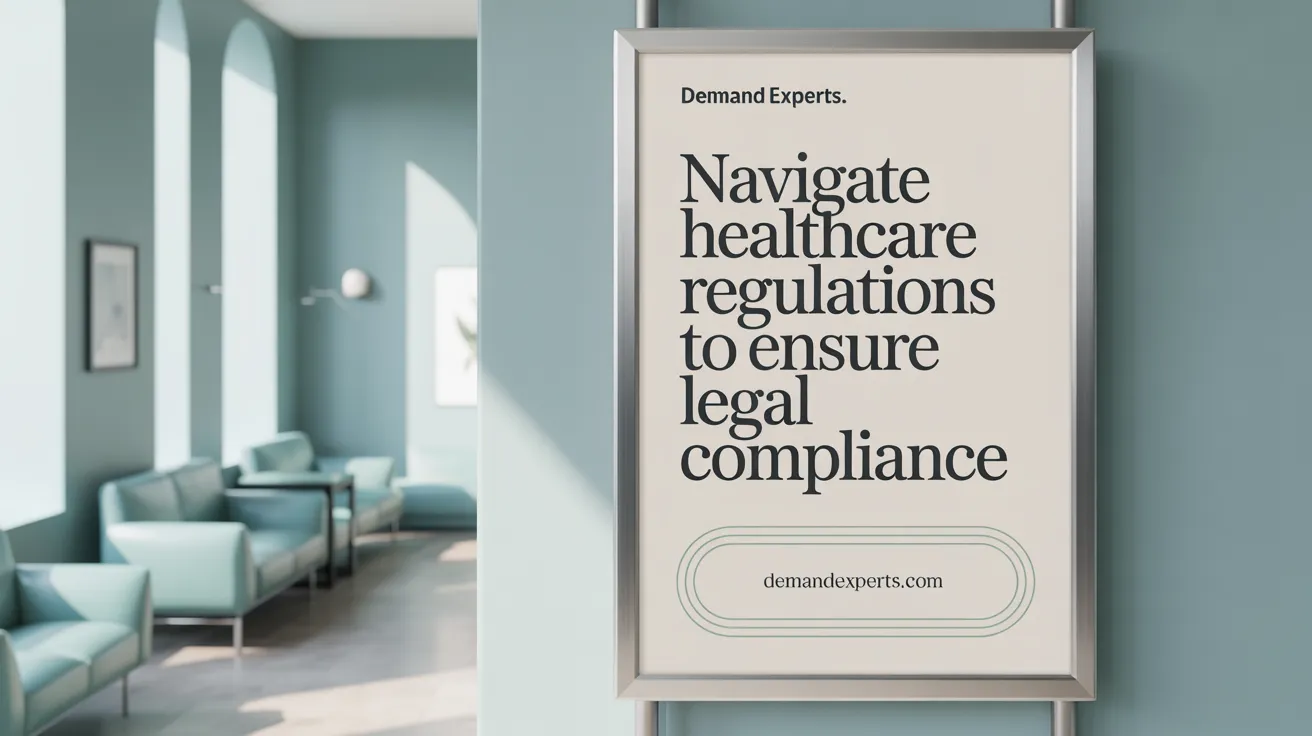Navigating Compliance in Healthcare Digital Marketing
Healthcare digital marketing presents unique challenges requiring strict adherence to a complex web of regulations designed to protect patient information and promote ethical practices. This article outlines the critical compliance standards, legal frameworks, and practical approaches digital marketing teams must follow to safeguard patient privacy and ensure regulatory conformity while effectively engaging audiences.
Core Healthcare Compliance Standards for Digital Marketing
What are the core healthcare compliance standards relevant to digital marketing activities, including legal requirements and regulatory guidelines?
Healthcare organizations engaging in digital marketing must navigate a complex regulatory environment designed to protect patient privacy, ensure data security, and promote truthful advertising practices.
One fundamental regulation is HIPAA (Health Insurance Portability and Accountability Act), which applies to covered entities such as healthcare providers, insurers, and their business associates. HIPAA’s Privacy, Security, and Breach Notification Rules set strict standards for handling Protected Health Information (PHI). Digital marketing activities must avoid sharing PHI without explicit patient authorization, use secure and encrypted data transmission methods, and rely exclusively on HIPAA-compliant platforms. Furthermore, organizations must establish signed Business Associate Agreements (BAAs) with all vendors handling PHI to ensure accountability and compliance.
The European Union’s GDPR (General Data Protection Regulation) also impacts global healthcare marketing, emphasizing transparency, explicit consent, data minimization, and patient rights to access and delete personal data. Although GDPR is European law, it influences global practices by requiring healthcare marketers to operate transparently about data collection and usage, regardless of location.
Additional regulations include the FTC’s guidelines, which promote truthful advertising and prohibit misleading health claims, and the Stark Law, which restricts physicians from making referrals to entities where they have a financial stake for the purpose of incentivized marketing.
To ensure compliance, healthcare marketers should incorporate employee training on privacy and data security, conduct regular audits of digital campaigns, develop clear privacy policies, and utilize analytics and communication tools that are verified as HIPAA- and GDPR-compliant. This comprehensive approach minimizes legal risks, protects patient data, and maintains trust in healthcare communications.
| Regulation | Focus Area | Implications for Digital Marketing | Additional Notes |
|---|---|---|---|
| HIPAA | Privacy, Security, Breach Notification | Secure data handling, patient authorization, signed BAAs | Most relevant for PHI, mandates encryption and secure communication |
| GDPR | Data transparency, consent, rights | Explicit consent, data access rights, transparent practices | Applies to organizations handling EU citizen data |
| FTC Guidelines | Truthful advertising | No deceptive health claims, truthful messaging | Protects consumers from misleading health information |
| Stark Law | Referral restrictions | Limits on referral-based marketing involving financial interests | Prevents incentivized or conflicted marketing actions |
Implementing these standards involves continuous employee education, disciplined vendor management, and rigorous audit processes. Staying updated on regulatory changes and maintaining thorough documentation are essential to uphold healthcare marketing integrity and compliance.
Ensuring HIPAA Compliance in Digital Marketing Initiatives
How can healthcare organizations ensure HIPAA compliance in their digital marketing efforts?
To ensure HIPAA compliance in digital marketing efforts, healthcare organizations must prioritize patient privacy and data security at every step. The first step is obtaining explicit, written patient authorization before using any protected health information (PHI) in marketing campaigns. This includes providing clear information about how the data will be used and giving patients an easy option to opt out (Patient Opt-Out Options).
Whenever possible, organizations should use de-identified or anonymized data that cannot be linked back to individuals. This approach allows marketing activities to target broader audiences without risking HIPAA violations stemming from PHI disclosures (HIPAA Marketing Communications).
Implementing strong technical safeguards such as encryption for emails and website data, access controls to restrict sensitive information, and comprehensive audit trails to monitor data access and sharing are vital (Encryption Protocols for PHI, Access Controls for PHI). These measures help protect electronic PHI (ePHI) from unauthorized access or breaches (Electronic PHI Security Measures).
Partnering with HIPAA-compliant marketing platforms and vendors is another essential step. Establishing Business Associate Agreements (BAAs) with such vendors ensures they understand and uphold HIPAA security standards. Regular audits of these systems and vendors help maintain compliance and identify potential vulnerabilities (Monitor Vendor HIPAA Compliance).
Staff training is crucial to embed a culture of privacy awareness. Employees involved in marketing should understand HIPAA regulations, the importance of data security, and proper handling of patient information across digital channels like social media, email, and online forms (Workforce HIPAA Training, HIPAA Workforce Training on Privacy and Security).
Finally, organizations should develop clear privacy policies, incorporate compliance checks into their workflows, and continuously monitor all digital marketing activities (Documented HIPAA Policies and Procedures, HIPAA Compliance Monitoring). Staying informed about regulatory updates and adjusting practices accordingly ensures ongoing HIPAA compliance, maintaining patient trust and avoiding costly violations (HIPAA Regulation Updates and Enforcement Notices).
Navigating Key Healthcare Marketing Regulations and Legal Considerations

What are the key healthcare marketing regulations and legal considerations, including laws like HIPAA Compliance Checklist, GDPR, Stark Law and physician kickbacks, and Medicare marketing rules?
Healthcare marketing must operate within a complex legal framework designed to protect patient rights, maintain transparency, and prevent unethical practices. HIPAA (Health Insurance Portability and Accountability Act) is central in the U.S., requiring healthcare providers and their marketing vendors to handle Protected Health Information (PHI) securely. This includes obtaining explicit patient consent before using personal health stories in campaigns and signing Business Associate Agreements (BAAs) with third-party vendors to ensure compliance.
The GDPR (General Data Protection Regulation) extends these privacy protections to individuals in the European Union, mandating transparency about data collection, the right for individuals to access and delete their data, and strict minimization of data used for marketing. Non-compliance can lead to hefty fines, even for U.S.-based organizations targeting EU citizens.
Further, the Stark Law imposes restrictions on self-referrals by physicians, particularly regarding financial relationships with ancillary service providers. Marketers must avoid incentivizing referrals or using testimonials that suggest financial benefits, as these can violate Stark Law regulations.
Lastly, Medicare marketing rules stipulate specific guidelines for promoting Medicare Advantage and Prescription Drug Plans, including truthful representations and compliance with CMS regulations. These impose additional constraints on how healthcare organizations communicate with potential beneficiaries.
In summary, healthcare marketers must ensure their promotional strategies are truthful and supported by evidence, respect patient privacy under HIPAA and GDPR, avoid incentivized referral schemes under Stark Law, and adhere to federal guidelines on Medicare plan advertising. Employing non-PHI metrics, securing proper legal agreements, and maintaining transparency are essential for compliant marketing.
Best Practices and Strategies for Compliant Healthcare Digital Marketing

What are the best practices and strategies for compliant healthcare digital marketing?
To ensure healthcare digital marketing stays within legal and ethical boundaries, organizations must follow strict protocols aligned with HIPAA Compliance Checklist. First and foremost, obtaining explicit patient consent before using or disclosing Protected Health Information (PHI) is essential. This involves clear, written authorization for any marketing communication involving PHI, and providing easy opt-out mechanisms for patients who wish to decline further contact (HIPAA Privacy Rule and marketing).
Avoiding the inclusion of PHI in digital tracking and targeting practices is crucial. Many common analytics platforms like Google Analytics are not HIPAA compliant because they do not sign Business Associate Agreements (BAAs) or safeguard PHI appropriately. Healthcare entities should utilize HIPAA-secure analytics and marketing tools that support encrypted data, de-identification, and role-based access controls.
Content strategies should emphasize privacy and patient education, focusing on general health tips, community outreach, and informational content that do not disclose personal health details (Healthcare marketing compliance). Social media engagement and website content must steer clear of sharing identifiable patient information and should follow strict privacy policies (Social Media for Healthcare).
Regular compliance audits, workforce training, and detailed documentation of all marketing activities help prevent inadvertent violations and foster a culture of privacy (Workforce HIPAA Training).
Creating a first-party data ecosystem, where patient and prospect data are collected via secure, encrypted consent management platforms, provides control over data use while reducing risks. Incorporating encryption, consent logging, and robust access controls ensures data integrity and patient trust (HIPAA-compliant digital marketing).
In summary, healthcare organizations should prioritize secure, consent-driven communication channels, utilize compliant analytics solutions, and reinforce staff training to maintain compliant and ethical digital marketing practices (HIPAA Compliance Program Development). These approaches facilitate effective outreach while safeguarding patient rights and avoiding costly legal repercussions.
For ongoing success, consult current regulations and partner with HIPAA-compliant MarTech vendors committed to security and privacy standards. Regularly updating policies and performing compliance assessments are vital to adapting to evolving legal guidance and maintaining ethical marketing practices in healthcare (HIPAA Regulation Updates and Enforcement Notices).
Implementing Compliance Checklists, Policies, and Tools for Healthcare Marketing

Healthcare organizations aiming to ensure compliance in their marketing efforts should begin by gaining a clear understanding of relevant regulations such as HIPAA Compliance Checklist, GDPR impact on healthcare marketing, and OSHA worker safety standards. This understanding helps in crafting policies that accurately reflect legal obligations and organizational activities. Policies should be comprehensive and tailored, addressing privacy protections, secure data handling, and staff responsibilities.
Developing detailed HIPAA Compliance Checklists is an effective way to verify adherence to these policies. These checklists should cover areas like patient consent protocols, secure data storage, secure communications, and proper use of digital marketing tools. Before launching campaigns, organizations should review these checklists thoroughly to ensure everything aligns with compliance standards.
Utilizing specialized tools that are compliant with healthcare regulations is crucial. Secure Customer Relationship Management (CRM) systems, encrypted email platforms, and privacy-conscious analytics tools—preferably with signed Business Associate Agreements (BAAs)—help prevent data breaches and unauthorized disclosures. These tools enable organizations to manage patient interactions and data collection securely.
Training staff regularly on compliance requirements, cybersecurity best practices, and proper handling of Protected Health Information (PHI) is essential. Continuous education ensures that team members are aware of their responsibilities and can recognize potential risks or violations.
Monitoring ongoing compliance should involve routine audits, clear breach response plans, and incident management procedures. Documenting every step—from policy creation and staff training to audits and breach handling—builds a transparent record. This documentation not only supports accountability but also ensures readiness for regulatory audits or investigations.
By systematically integrating these policies, checklists, tools, and training programs, healthcare marketers can maintain robust compliance, mitigate legal risks, and foster trust with patients and regulators.
Legal Considerations and Risk Management in Healthcare Marketing Compliance
Managing risks associated with PHI misuse and HIPAA violations
Healthcare marketing professionals must be vigilant to prevent the mishandling of protected health information (PHI). Unauthorized disclosures, such as sharing identifiable patient data without consent, can result in substantial fines and legal action. It's essential to localize all data practices within HIPAA guidelines, avoiding the use of non-compliant tools that do not sign Business Associate Agreements (BAAs). Regular audits and monitoring help identify potential risks and gaps in compliance.
Ensuring staff training on disclosure and privacy protocols
Staff education is a cornerstone of legal risk mitigation. All team members involved in healthcare marketing should undergo continuous training on privacy regulations, proper data handling, and secure communication practices. Well-informed staff can recognize violations early and adhere to protocols that protect patient data, reducing the chance of accidental breaches.
Contracting HIPAA-compliant vendors with BAAs to reduce liability
Partnering with vendors who are compliant with HIPAA and willing to sign BAAs is vital. These agreements specify responsibilities for protecting PHI and help distribute compliance obligations clearly. Choosing secure platforms for email marketing, data analytics, and patient communication ensures that agencies uphold privacy standards, reducing liability and strengthening trust.
Developing policies around social media engagement
Social media is a powerful tool but poses risks if not managed carefully. Developing strict policies on what can be posted, how to handle patient comments, and procedures for responding to potential privacy breaches is necessary. Avoid disclosing any PHI and obtain explicit patient consent before sharing testimonials or healthcare stories. See the Social Media for Healthcare HIPAA compliance checklist for guidance.
Engaging legal counsel for campaign review and risk mitigation
Legal expertise plays a crucial role in designing compliant marketing campaigns. Consulting with attorneys experienced in healthcare law before launching initiatives ensures adherence to regulations, helps interpret emerging guidelines, and provides strategies for addressing complex compliance challenges. Refer to Compliance Legal Audit Checklist for Healthcare Organizations.
Conducting regular risk assessments and audits
Continuous review through risk assessments and compliance audits helps detect vulnerabilities early. These evaluations should be updated regularly to reflect new laws, technology updates, and industry best practices. Maintaining thorough documentation of all compliance efforts demonstrates due diligence if regulatory questions arise. See Conducting HIPAA Risk Assessments.
| Aspect | Action | Details |
|---|---|---|
| Data Handling | Use compliant tools | Sign BAAs, encrypt data, segregate PHI from non-PHI data |
| Staff Training | Ongoing education | Cover disclosure protocols, secure communication, social media use |
| Vendor Management | Contract with compliant vendors | Ensure BAAs are signed and platforms meet HIPAA standards |
| Policy Development | Create clear policies | Include social media, data sharing, consent procedures |
| Legal Oversight | Engage legal counsel | Review campaigns, interpret laws, mitigate risks |
| Risk Management | Regular audits and assessments | Identify vulnerabilities, document compliance activities |
For healthcare marketers, understanding and proactively managing legal risks are essential to maintaining compliance and protecting patient privacy. Implementing robust policies, training staff, partnering with compliant vendors, and regularly auditing practices form the backbone of effective risk management in healthcare marketing.
Educating Healthcare Marketing Teams on Compliance Standards

How can healthcare organizations educate their marketing teams about regulatory standards and compliance measures?
Healthcare organizations can effectively educate their marketing staff through comprehensive, continuous training initiatives that encompass essential regulations such as HIPAA Compliance Checklist, Healthcare marketing compliance, and regional legal requirements.
Utilizing a mix of educational tools enhances learning outcomes. E-learning modules, interactive quizzes, and real-life case studies help staff grasp complex regulatory concepts and apply best practices (HIPAA Compliance in Digital Marketing, Healthcare Compliance Best Practices).
Role-based scenarios are particularly beneficial, allowing team members to explore compliance challenges specific to their responsibilities (HIPAA Compliance Program Development). Regular updates on regulatory changes keep the team informed of evolving standards and maintain compliance awareness (HIPAA Regulation Updates and Enforcement Notices).
Providing accessible resources like detailed playbooks, checklists, and policies supports daily decision-making and promotes consistent application of regulations. These materials serve as quick references for team members in the midst of campaign planning and execution (Compliance Checklists, Healthcare compliance forms).
To reinforce compliance efforts, organizations should schedule frequent campaign audits and feedback sessions where team members can review activities, discuss challenges, and receive guidance from compliance officers (HIPAA Audit for PHI Usage, Monitoring HIPAA Security).
Fostering a culture of accountability and ethical marketing practices is essential. Leadership commitment, transparent communication, and a clear code of conduct motivate teams to prioritize privacy and regulatory adherence (HIPAA Compliance Program Development, Healthcare Compliance Programs).
Finally, staying current with regulatory updates and integrating new requirements into training programs ensures that marketing teams operate within legal frameworks, protect patient trust, and support the organization’s reputation for integrity (HIPAA Compliance Checklist, HIPAA Privacy, Security, and Breach Notification Rules).
Strategies to Maintain Patient Privacy and Data Security in Healthcare Marketing

What strategies can healthcare marketers use to maintain patient privacy and data security in digital marketing?
Healthcare marketers face the critical task of protecting patient privacy while leveraging digital channels for outreach. A primary approach involves deploying robust technical safeguards. This includes data encryption both in transit and at rest, ensuring secure communication channels—such as HTTPS and encrypted emails—and regular software updates to patch vulnerabilities. Implementing strict access controls and multi-factor authentication limits data access to authorized personnel only (HIPAA Security Officer Appointment).
Data anonymization and de-identification practices are vital. When analyzing marketing data, personally identifiable information should be removed or obscured, reducing the risk if data is leaked or accessed unauthorizedly (HIPAA compliance in digital marketing). Laws like HIPAA, GDPR, and CCPA set strict standards for data handling. Complying with these regulations entails obtaining explicit patient consent before collecting or using their data, providing rights to access or delete personal information, and partnering with platforms that sign Business Associate Agreements (BAAs).
Staff education is another key component. Regular training on privacy policies, security best practices, and incident response plans helps prevent accidental disclosures and prepares teams to respond swiftly to potential breaches (Workforce HIPAA Training). Creating a culture of transparency about how patient data is managed builds trust, encouraging patients to engage with digital marketing efforts (Healthcare marketing compliance).
Finally, collaboration with HIPAA-compliant marketing technologies enhances security. This includes choosing vendors and tools that prioritize data protection, such as secure CRMs, HIPAA-compliant email services like Paubox, and secure analytics platforms (HIPAA-compliant email marketing). Such measures ensure that digital outreach aligns with legal standards and maintains the integrity of patient data.
Building a Culture of Compliance in Healthcare Digital Marketing
Achieving and maintaining compliance in healthcare digital marketing requires a comprehensive approach anchored in understanding and applying regulatory standards such as HIPAA, GDPR, Stark Law, and Medicare marketing rules. By implementing clear policies, rigorous training programs, and utilizing compliant technologies, healthcare organizations can effectively protect patient information while engaging audiences with integrity. Regular audits, risk assessments, and a commitment to transparency foster trust among patients and regulators alike. Ultimately, cultivating a culture of compliance not only mitigates legal risks but also enhances the credibility and success of healthcare marketing initiatives in an increasingly digital world.
Navigating Compliance in Healthcare Digital Marketing
Healthcare digital marketing presents unique challenges requiring strict adherence to a complex web of regulations designed to protect patient information and promote ethical practices. This article outlines the critical compliance standards, legal frameworks, and practical approaches digital marketing teams must follow to safeguard patient privacy and ensure regulatory conformity while effectively engaging audiences.
Core Healthcare Compliance Standards for Digital Marketing
What are the core healthcare compliance standards relevant to digital marketing activities, including legal requirements and regulatory guidelines?
Healthcare organizations engaging in digital marketing must navigate a complex regulatory environment designed to protect patient privacy, ensure data security, and promote truthful advertising practices.
One fundamental regulation is HIPAA (Health Insurance Portability and Accountability Act), which applies to covered entities such as healthcare providers, insurers, and their business associates. HIPAA’s Privacy, Security, and Breach Notification Rules set strict standards for handling Protected Health Information (PHI). Digital marketing activities must avoid sharing PHI without explicit patient authorization, use secure and encrypted data transmission methods, and rely exclusively on HIPAA-compliant platforms. Furthermore, organizations must establish signed Business Associate Agreements (BAAs) with all vendors handling PHI to ensure accountability and compliance.
The European Union’s GDPR (General Data Protection Regulation) also impacts global healthcare marketing, emphasizing transparency, explicit consent, data minimization, and patient rights to access and delete personal data. Although GDPR is European law, it influences global practices by requiring healthcare marketers to operate transparently about data collection and usage, regardless of location.
Additional regulations include the FTC’s guidelines, which promote truthful advertising and prohibit misleading health claims, and the Stark Law, which restricts physicians from making referrals to entities where they have a financial stake for the purpose of incentivized marketing.
To ensure compliance, healthcare marketers should incorporate employee training on privacy and data security, conduct regular audits of digital campaigns, develop clear privacy policies, and utilize analytics and communication tools that are verified as HIPAA- and GDPR-compliant. This comprehensive approach minimizes legal risks, protects patient data, and maintains trust in healthcare communications.
| Regulation | Focus Area | Implications for Digital Marketing | Additional Notes |
|---|---|---|---|
| HIPAA | Privacy, Security, Breach Notification | Secure data handling, patient authorization, signed BAAs | Most relevant for PHI, mandates encryption and secure communication |
| GDPR | Data transparency, consent, rights | Explicit consent, data access rights, transparent practices | Applies to organizations handling EU citizen data |
| FTC Guidelines | Truthful advertising | No deceptive health claims, truthful messaging | Protects consumers from misleading health information |
| Stark Law | Referral restrictions | Limits on referral-based marketing involving financial interests | Prevents incentivized or conflicted marketing actions |
Implementing these standards involves continuous employee education, disciplined vendor management, and rigorous audit processes. Staying updated on regulatory changes and maintaining thorough documentation are essential to uphold healthcare marketing integrity and compliance.
Ensuring HIPAA Compliance in Digital Marketing Initiatives
How can healthcare organizations ensure HIPAA compliance in their digital marketing efforts?
To ensure HIPAA compliance in digital marketing efforts, healthcare organizations must prioritize patient privacy and data security at every step. The first step is obtaining explicit, written patient authorization before using any protected health information (PHI) in marketing campaigns. This includes providing clear information about how the data will be used and giving patients an easy option to opt out (Patient Opt-Out Options).
Whenever possible, organizations should use de-identified or anonymized data that cannot be linked back to individuals. This approach allows marketing activities to target broader audiences without risking HIPAA violations stemming from PHI disclosures (HIPAA Marketing Communications).
Implementing strong technical safeguards such as encryption for emails and website data, access controls to restrict sensitive information, and comprehensive audit trails to monitor data access and sharing are vital (Encryption Protocols for PHI, Access Controls for PHI). These measures help protect electronic PHI (ePHI) from unauthorized access or breaches (Electronic PHI Security Measures).
Partnering with HIPAA-compliant marketing platforms and vendors is another essential step. Establishing Business Associate Agreements (BAAs) with such vendors ensures they understand and uphold HIPAA security standards. Regular audits of these systems and vendors help maintain compliance and identify potential vulnerabilities (Monitor Vendor HIPAA Compliance).
Staff training is crucial to embed a culture of privacy awareness. Employees involved in marketing should understand HIPAA regulations, the importance of data security, and proper handling of patient information across digital channels like social media, email, and online forms (Workforce HIPAA Training, HIPAA Workforce Training on Privacy and Security).
Finally, organizations should develop clear privacy policies, incorporate compliance checks into their workflows, and continuously monitor all digital marketing activities (Documented HIPAA Policies and Procedures, HIPAA Compliance Monitoring). Staying informed about regulatory updates and adjusting practices accordingly ensures ongoing HIPAA compliance, maintaining patient trust and avoiding costly violations (HIPAA Regulation Updates and Enforcement Notices).
Navigating Key Healthcare Marketing Regulations and Legal Considerations

What are the key healthcare marketing regulations and legal considerations, including laws like HIPAA Compliance Checklist, GDPR, Stark Law and physician kickbacks, and Medicare marketing rules?
Healthcare marketing must operate within a complex legal framework designed to protect patient rights, maintain transparency, and prevent unethical practices. HIPAA (Health Insurance Portability and Accountability Act) is central in the U.S., requiring healthcare providers and their marketing vendors to handle Protected Health Information (PHI) securely. This includes obtaining explicit patient consent before using personal health stories in campaigns and signing Business Associate Agreements (BAAs) with third-party vendors to ensure compliance.
The GDPR (General Data Protection Regulation) extends these privacy protections to individuals in the European Union, mandating transparency about data collection, the right for individuals to access and delete their data, and strict minimization of data used for marketing. Non-compliance can lead to hefty fines, even for U.S.-based organizations targeting EU citizens.
Further, the Stark Law imposes restrictions on self-referrals by physicians, particularly regarding financial relationships with ancillary service providers. Marketers must avoid incentivizing referrals or using testimonials that suggest financial benefits, as these can violate Stark Law regulations.
Lastly, Medicare marketing rules stipulate specific guidelines for promoting Medicare Advantage and Prescription Drug Plans, including truthful representations and compliance with CMS regulations. These impose additional constraints on how healthcare organizations communicate with potential beneficiaries.
In summary, healthcare marketers must ensure their promotional strategies are truthful and supported by evidence, respect patient privacy under HIPAA and GDPR, avoid incentivized referral schemes under Stark Law, and adhere to federal guidelines on Medicare plan advertising. Employing non-PHI metrics, securing proper legal agreements, and maintaining transparency are essential for compliant marketing.
Best Practices and Strategies for Compliant Healthcare Digital Marketing

What are the best practices and strategies for compliant healthcare digital marketing?
To ensure healthcare digital marketing stays within legal and ethical boundaries, organizations must follow strict protocols aligned with HIPAA Compliance Checklist. First and foremost, obtaining explicit patient consent before using or disclosing Protected Health Information (PHI) is essential. This involves clear, written authorization for any marketing communication involving PHI, and providing easy opt-out mechanisms for patients who wish to decline further contact (HIPAA Privacy Rule and marketing).
Avoiding the inclusion of PHI in digital tracking and targeting practices is crucial. Many common analytics platforms like Google Analytics are not HIPAA compliant because they do not sign Business Associate Agreements (BAAs) or safeguard PHI appropriately. Healthcare entities should utilize HIPAA-secure analytics and marketing tools that support encrypted data, de-identification, and role-based access controls.
Content strategies should emphasize privacy and patient education, focusing on general health tips, community outreach, and informational content that do not disclose personal health details (Healthcare marketing compliance). Social media engagement and website content must steer clear of sharing identifiable patient information and should follow strict privacy policies (Social Media for Healthcare).
Regular compliance audits, workforce training, and detailed documentation of all marketing activities help prevent inadvertent violations and foster a culture of privacy (Workforce HIPAA Training).
Creating a first-party data ecosystem, where patient and prospect data are collected via secure, encrypted consent management platforms, provides control over data use while reducing risks. Incorporating encryption, consent logging, and robust access controls ensures data integrity and patient trust (HIPAA-compliant digital marketing).
In summary, healthcare organizations should prioritize secure, consent-driven communication channels, utilize compliant analytics solutions, and reinforce staff training to maintain compliant and ethical digital marketing practices (HIPAA Compliance Program Development). These approaches facilitate effective outreach while safeguarding patient rights and avoiding costly legal repercussions.
For ongoing success, consult current regulations and partner with HIPAA-compliant MarTech vendors committed to security and privacy standards. Regularly updating policies and performing compliance assessments are vital to adapting to evolving legal guidance and maintaining ethical marketing practices in healthcare (HIPAA Regulation Updates and Enforcement Notices).
Implementing Compliance Checklists, Policies, and Tools for Healthcare Marketing

Healthcare organizations aiming to ensure compliance in their marketing efforts should begin by gaining a clear understanding of relevant regulations such as HIPAA Compliance Checklist, GDPR impact on healthcare marketing, and OSHA worker safety standards. This understanding helps in crafting policies that accurately reflect legal obligations and organizational activities. Policies should be comprehensive and tailored, addressing privacy protections, secure data handling, and staff responsibilities.
Developing detailed HIPAA Compliance Checklists is an effective way to verify adherence to these policies. These checklists should cover areas like patient consent protocols, secure data storage, secure communications, and proper use of digital marketing tools. Before launching campaigns, organizations should review these checklists thoroughly to ensure everything aligns with compliance standards.
Utilizing specialized tools that are compliant with healthcare regulations is crucial. Secure Customer Relationship Management (CRM) systems, encrypted email platforms, and privacy-conscious analytics tools—preferably with signed Business Associate Agreements (BAAs)—help prevent data breaches and unauthorized disclosures. These tools enable organizations to manage patient interactions and data collection securely.
Training staff regularly on compliance requirements, cybersecurity best practices, and proper handling of Protected Health Information (PHI) is essential. Continuous education ensures that team members are aware of their responsibilities and can recognize potential risks or violations.
Monitoring ongoing compliance should involve routine audits, clear breach response plans, and incident management procedures. Documenting every step—from policy creation and staff training to audits and breach handling—builds a transparent record. This documentation not only supports accountability but also ensures readiness for regulatory audits or investigations.
By systematically integrating these policies, checklists, tools, and training programs, healthcare marketers can maintain robust compliance, mitigate legal risks, and foster trust with patients and regulators.
Legal Considerations and Risk Management in Healthcare Marketing Compliance
Managing risks associated with PHI misuse and HIPAA violations
Healthcare marketing professionals must be vigilant to prevent the mishandling of protected health information (PHI). Unauthorized disclosures, such as sharing identifiable patient data without consent, can result in substantial fines and legal action. It's essential to localize all data practices within HIPAA guidelines, avoiding the use of non-compliant tools that do not sign Business Associate Agreements (BAAs). Regular audits and monitoring help identify potential risks and gaps in compliance.
Ensuring staff training on disclosure and privacy protocols
Staff education is a cornerstone of legal risk mitigation. All team members involved in healthcare marketing should undergo continuous training on privacy regulations, proper data handling, and secure communication practices. Well-informed staff can recognize violations early and adhere to protocols that protect patient data, reducing the chance of accidental breaches.
Contracting HIPAA-compliant vendors with BAAs to reduce liability
Partnering with vendors who are compliant with HIPAA and willing to sign BAAs is vital. These agreements specify responsibilities for protecting PHI and help distribute compliance obligations clearly. Choosing secure platforms for email marketing, data analytics, and patient communication ensures that agencies uphold privacy standards, reducing liability and strengthening trust.
Developing policies around social media engagement
Social media is a powerful tool but poses risks if not managed carefully. Developing strict policies on what can be posted, how to handle patient comments, and procedures for responding to potential privacy breaches is necessary. Avoid disclosing any PHI and obtain explicit patient consent before sharing testimonials or healthcare stories. See the Social Media for Healthcare HIPAA compliance checklist for guidance.
Engaging legal counsel for campaign review and risk mitigation
Legal expertise plays a crucial role in designing compliant marketing campaigns. Consulting with attorneys experienced in healthcare law before launching initiatives ensures adherence to regulations, helps interpret emerging guidelines, and provides strategies for addressing complex compliance challenges. Refer to Compliance Legal Audit Checklist for Healthcare Organizations.
Conducting regular risk assessments and audits
Continuous review through risk assessments and compliance audits helps detect vulnerabilities early. These evaluations should be updated regularly to reflect new laws, technology updates, and industry best practices. Maintaining thorough documentation of all compliance efforts demonstrates due diligence if regulatory questions arise. See Conducting HIPAA Risk Assessments.
| Aspect | Action | Details |
|---|---|---|
| Data Handling | Use compliant tools | Sign BAAs, encrypt data, segregate PHI from non-PHI data |
| Staff Training | Ongoing education | Cover disclosure protocols, secure communication, social media use |
| Vendor Management | Contract with compliant vendors | Ensure BAAs are signed and platforms meet HIPAA standards |
| Policy Development | Create clear policies | Include social media, data sharing, consent procedures |
| Legal Oversight | Engage legal counsel | Review campaigns, interpret laws, mitigate risks |
| Risk Management | Regular audits and assessments | Identify vulnerabilities, document compliance activities |
For healthcare marketers, understanding and proactively managing legal risks are essential to maintaining compliance and protecting patient privacy. Implementing robust policies, training staff, partnering with compliant vendors, and regularly auditing practices form the backbone of effective risk management in healthcare marketing.
Educating Healthcare Marketing Teams on Compliance Standards

How can healthcare organizations educate their marketing teams about regulatory standards and compliance measures?
Healthcare organizations can effectively educate their marketing staff through comprehensive, continuous training initiatives that encompass essential regulations such as HIPAA Compliance Checklist, Healthcare marketing compliance, and regional legal requirements.
Utilizing a mix of educational tools enhances learning outcomes. E-learning modules, interactive quizzes, and real-life case studies help staff grasp complex regulatory concepts and apply best practices (HIPAA Compliance in Digital Marketing, Healthcare Compliance Best Practices).
Role-based scenarios are particularly beneficial, allowing team members to explore compliance challenges specific to their responsibilities (HIPAA Compliance Program Development). Regular updates on regulatory changes keep the team informed of evolving standards and maintain compliance awareness (HIPAA Regulation Updates and Enforcement Notices).
Providing accessible resources like detailed playbooks, checklists, and policies supports daily decision-making and promotes consistent application of regulations. These materials serve as quick references for team members in the midst of campaign planning and execution (Compliance Checklists, Healthcare compliance forms).
To reinforce compliance efforts, organizations should schedule frequent campaign audits and feedback sessions where team members can review activities, discuss challenges, and receive guidance from compliance officers (HIPAA Audit for PHI Usage, Monitoring HIPAA Security).
Fostering a culture of accountability and ethical marketing practices is essential. Leadership commitment, transparent communication, and a clear code of conduct motivate teams to prioritize privacy and regulatory adherence (HIPAA Compliance Program Development, Healthcare Compliance Programs).
Finally, staying current with regulatory updates and integrating new requirements into training programs ensures that marketing teams operate within legal frameworks, protect patient trust, and support the organization’s reputation for integrity (HIPAA Compliance Checklist, HIPAA Privacy, Security, and Breach Notification Rules).
Strategies to Maintain Patient Privacy and Data Security in Healthcare Marketing

What strategies can healthcare marketers use to maintain patient privacy and data security in digital marketing?
Healthcare marketers face the critical task of protecting patient privacy while leveraging digital channels for outreach. A primary approach involves deploying robust technical safeguards. This includes data encryption both in transit and at rest, ensuring secure communication channels—such as HTTPS and encrypted emails—and regular software updates to patch vulnerabilities. Implementing strict access controls and multi-factor authentication limits data access to authorized personnel only (HIPAA Security Officer Appointment).
Data anonymization and de-identification practices are vital. When analyzing marketing data, personally identifiable information should be removed or obscured, reducing the risk if data is leaked or accessed unauthorizedly (HIPAA compliance in digital marketing). Laws like HIPAA, GDPR, and CCPA set strict standards for data handling. Complying with these regulations entails obtaining explicit patient consent before collecting or using their data, providing rights to access or delete personal information, and partnering with platforms that sign Business Associate Agreements (BAAs).
Staff education is another key component. Regular training on privacy policies, security best practices, and incident response plans helps prevent accidental disclosures and prepares teams to respond swiftly to potential breaches (Workforce HIPAA Training). Creating a culture of transparency about how patient data is managed builds trust, encouraging patients to engage with digital marketing efforts (Healthcare marketing compliance).
Finally, collaboration with HIPAA-compliant marketing technologies enhances security. This includes choosing vendors and tools that prioritize data protection, such as secure CRMs, HIPAA-compliant email services like Paubox, and secure analytics platforms (HIPAA-compliant email marketing). Such measures ensure that digital outreach aligns with legal standards and maintains the integrity of patient data.
Building a Culture of Compliance in Healthcare Digital Marketing
Achieving and maintaining compliance in healthcare digital marketing requires a comprehensive approach anchored in understanding and applying regulatory standards such as HIPAA, GDPR, Stark Law, and Medicare marketing rules. By implementing clear policies, rigorous training programs, and utilizing compliant technologies, healthcare organizations can effectively protect patient information while engaging audiences with integrity. Regular audits, risk assessments, and a commitment to transparency foster trust among patients and regulators alike. Ultimately, cultivating a culture of compliance not only mitigates legal risks but also enhances the credibility and success of healthcare marketing initiatives in an increasingly digital world.






